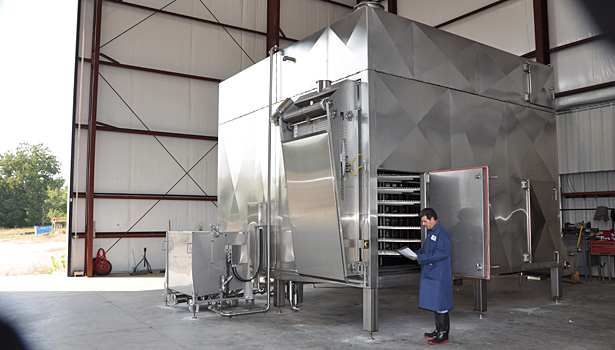Unitherm, Grote Co-Develop Secondary Cooking Machines to Improve Food Safety




Responsibility for ensuring the safety of processed foods ultimately rests with food processors. HACCP (Hazard Analysis and Critical Control Point) principles state that food processors must follow a systematic way of identifying food safety hazards and making sure that they are being controlled day-in, day-out.
While this principle has been accepted and practiced by food processors, one of the primary challenges is maintaining sanitary secondary operations in the production line after a protein (beef, poultry or seafood) is cooked. For example, slicing, slitting, washing, conveying and packaging.
When a protein leaves an oven, it is free of pathogen and bacteria because the high-temperature cooking takes care of that. However, risks of contamination begin to rise after the product begins to cool or, in some cases, after it has been chilled.
Because many processing lines run for 16 consecutive hours, the opportunity exists for bacteria growth throughout the day. Unless secondary equipment is sanitized properly at the necessary intervals, pathogens and other bacteria can build up on this equipment and contaminate product as it moves down the line. Pathogens can lead to final products that present a public health risk, and bacteria can dramatically reduce shelf life.
Going above and beyond
In meeting these food safety challenges post cooking, it is critical to understand the relationship between food processing equipment manufacturers and food processors.
Unitherm Food Systems, a Bristow, Okla.-based manufacturer of thermal food processing equipment, faced such a challenge when founder and chairman David Howard mapped out an innovative solution to prevent the growth of pathogens and bacteria that occurs on slitting equipment used to cut cooked beef and chicken strips. The issue of potential contamination post-cooking first came to Howard’s attention three years earlier when he was invited as a food safety expert to identify and help solve an e-coli problem in a new processing plant.
While he was there, he noted that the critical exposure time that occurred to proteins after the cooking process and through to the final packaging created some serious potential food safety issues. For example, there were surfaces where bacteria could grow throughout the day, and the meat traveled over those surfaces.
“At the point when the meat exits the oven, it is pathogen-free,” says Howard. “Then, it goes through the slitting blades, and all of the product becomes intermingled. If there is a pathogen or high-bacteria count present on the blades, every single piece of meat that goes through there could have the opportunity to be contaminated.”
To solve the problem, Howard envisioned a system in which the meat would come out of the oven and fall directly in the meat slitters, while other components such as the conveyor belt could be designed to be self-sterilizing during the production process. At the end of that line, the product could then be immediately packaged.
The concept was unique in that it uses steam instead of conventional chemical cleaning techniques, such as cleaning the equipment with appropriate chemicals. This method calls for frequent checking of the bacterial load by swabbing the equipment and measuring the growth, then treating it with chemicals as required. Pathogens are another matter. Pathogens on surfaces that come in contact with the product can grow a biofilm that can mutate and become resistant to chemicals.
Steam, on the other hand, utilizes energy – not chemicals – to instantaneously kill pathogens and/or bacteria.
“Steam is superior to chemical cleaning because pathogens can mutate and become resistant to chemicals,” Howard says. “Because the slitter is placed at the exit of the oven and does not touch any other surface, it remains pathogen free. At that point, you could proceed directly to final packaging.”
Although Unitherm offers a variety of thermal processing, chilling, pasteurizing and hygiene equipment, it is not in the business of manufacturing slitters or supplying conveyors.
“As a company that doesn’t make slitters, it can be frustrating,” says Howard. “You know there’s a solution that will make the process safer, but you can’t necessarily just do it because it is outside of the scope of what your company offers.”
The strategic alliance
To realize his vision of a self-sterilizing slicer/slitter using steam, Howard was faced with either manufacturing such a product at Unitherm, or finding an existing manufacturer willing to engage in a joint partnership to develop the new concept.
Howard quickly dismissed the idea of creating the product in house, however.
“There are plenty of companies in the world that make slicers and slitters. It makes no sense for Unitherm to say, ‘Us too. Here’s a one-off,’” he adds.
That’s why Howard contacted Bob Grote, vice president of the Grote Co., a Columbus, Ohio, manufacturer of automated slitter/slicer/applicator systems for food processors.
“They are a very reputable company with a solid management team that you can go and talk to about innovative ideas. They are very open to looking at [potential] process improvements,” says Howard.
“A few years ago, I recognized that we had to begin doing business a little differently to truly optimize what we have to offer our customers,” says Grote. “Not having expertise in every field that is associated with our company, I came to the conclusion that strategic alignments would be very beneficial to not only us, but also to the food processors.”
Fast-track development
The patent-pending design involved building a machine that could be attached to the end of Unitherm’s spiral ovens. The slitter could be used inline and then rotate out of the way when not required. Based on the actual bacterial counts measured, steam would then be applied to the blades at specific time intervals.
Grote engineers provided the initial equipment design within only a few weeks.
“We make a variety of sliders and slitters, but haven’t incorporated steam sterilization into any of our equipment before,” Grote says. “The trick with this slitter was to modify it to accommodate and trap the steam and add a jacket or shroud around it to contain the steam. We also had to make adjustments to the materials we used in the slitter itself to allow for the higher operating temperatures.”
In operation, the combination slitter and steam sterilizer is placed right at the exit of the oven. A steam shroud encloses the slitter, and steam is pulsed into the shroud to maintain the desired temperature range. The enclosed steam keeps the temperature at a level that will kill any pathogens or bacteria.
This self-sterilizing slitting system still requires periodic cleaning, but the intervals will result in much less downtime than is normally required for conventional chemical sterilization.
By agreement, Unitherm can sell the product for use on its spiral ovens and Grote can sell the product on Unitherm or any other oven manufacturer’s equipment. In fact, Unitherm already has several self-sterilizing slitters in operation at numerous food processing plants. Meanwhile, Howard is working on another improvement related to packaging of the beef and chicken fajita meat. One option that would eliminate any additional contamination in the post-cooking and slicing process would be to have it drop into a bag that is immediately vacuum-sealed. This hot-fill technique would extend the product’s shelf life and eliminate the need to freeze it—only chilling would be required.
“Most food safety issues that exist in food processing have an engineering solution,” says Howard. “And, if that solution requires expertise that is outside of a manufacturer’s business model or product offerings, then by entering into a strategic relationship with the right partner, the solution is attainable. That stimulates revenue for those involved in the solution, but more importantly, benefits many food processors as well.”
Looking for a reprint of this article?
From high-res PDFs to custom plaques, order your copy today!







